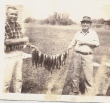Quota achievement with my company was rewarded each year with an event at a very fashionable location and this quota year’s was in Miami Beach. Ample free time allowed us to choose from several prepaid options, offshore fishing, sightseeing, golf, tennis and, of course, I picked fishing, however there was one drawback.
High pressure was dominating the area causing the wind to really be blowing in from the ocean, 30steady gusting to 40. This, in turn, built up the normally moderate seas to 8 to 10 feet and most charter Captains were reluctant to even venture out, citing boat safety. One Captain finally agreed to take his boat out, but he said to us, “If anyone gets seasick, don’t blame me”.
The 4 of us on the charter loaded up our gear on the, 36 footer and the Captain took the boat down the channel, turned left (to port) and headed toward the ocean. Before we cleared the jetties the seas were already building and once we cleared them, the seas were almost monstrous. Up, down, the boat was shuddering, we were already wet from the wind and spray and, frankly, I was concerned for our safety and how the Captain was going to come about and head back in.
We hadn’t even covered a mile, a mile of a lot of ups and downs, when the first case of seasickness hit us. A female salesman from Chicago rushed to the side, then a salesman from Oklahoma City followed suit, but both of them, even though they were sick, soldiered on. Both my friend from Houston and I, being experienced boaters, were starting to get a little “green” feeling, even the mate was turning pale and the Captain laughed and looked down at all of us and said, “You all asked for it!”
The Mate said to me, “We’re less than 2 miles out and I hate to think about putting the lines out and I’m even getting sick.” Hearing that, I climbed up to the upper cockpit and sat down beside the Captain, leaned over and said, “Calf rope, we’ve had enough! Take us back in.” The Captain replied, “Me Too”, skillfully topped a wave, cut the wheel to the right, powered up, slid into the trough, and climbed up the backside of the next wave! My earlier worries were unfounded.
At a faster clip, we rode the waves back in, cleared the jetties, picked up speed and turned to starboard (right) back up the channel to the marina. With the seas smoothing out and our boat picking up speed, everyone was feeling better. By the time we docked the boat and the saleslady from Chicago and the salesman from Ok City, touched the dock, they we’re miraculously healed! As we got out of the boat, both of the guy’s from Houston, and all of us, of us felt much better too!






